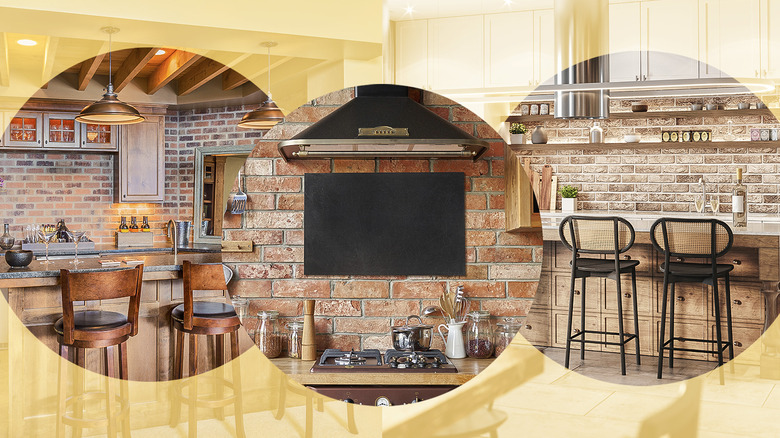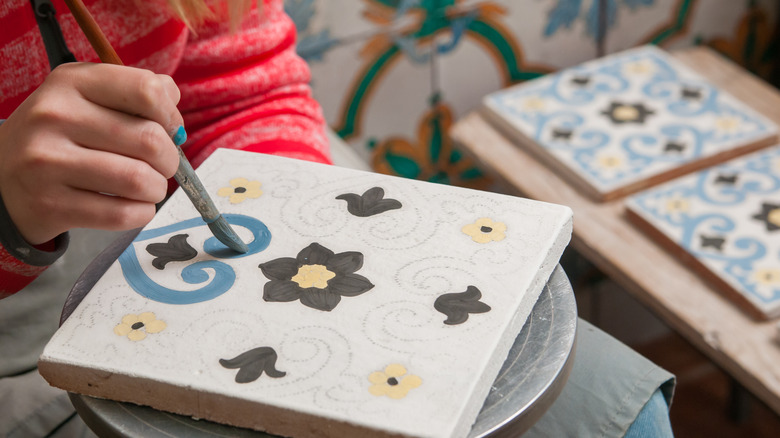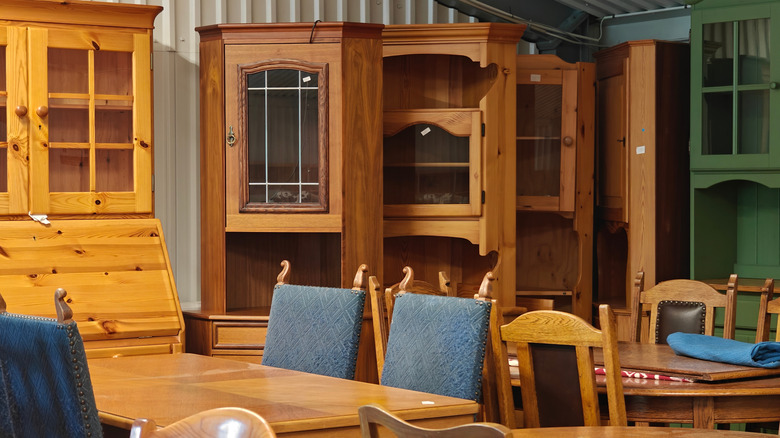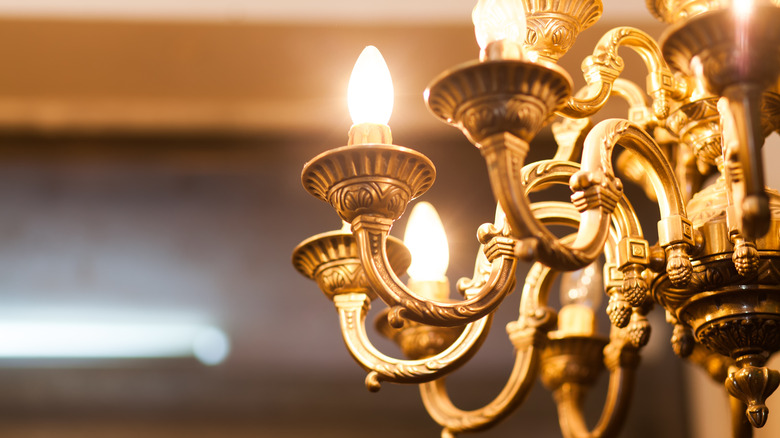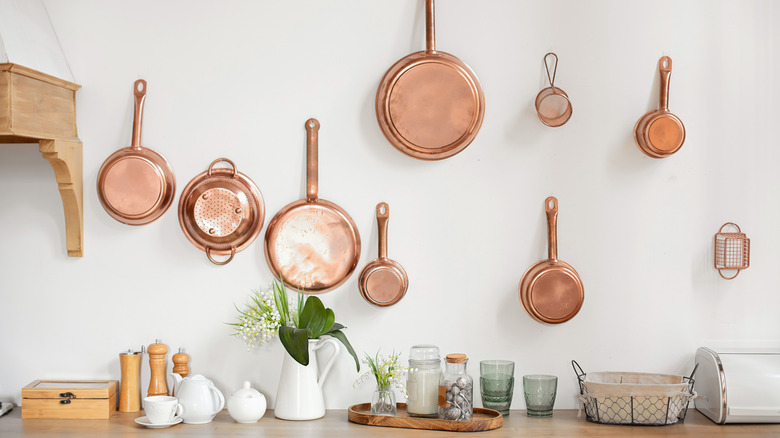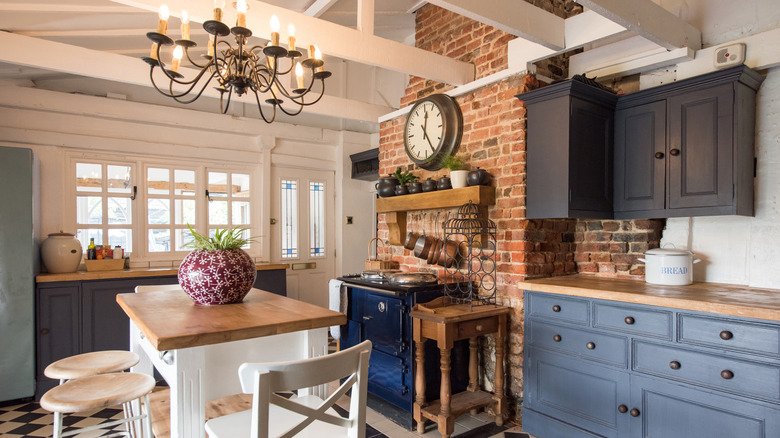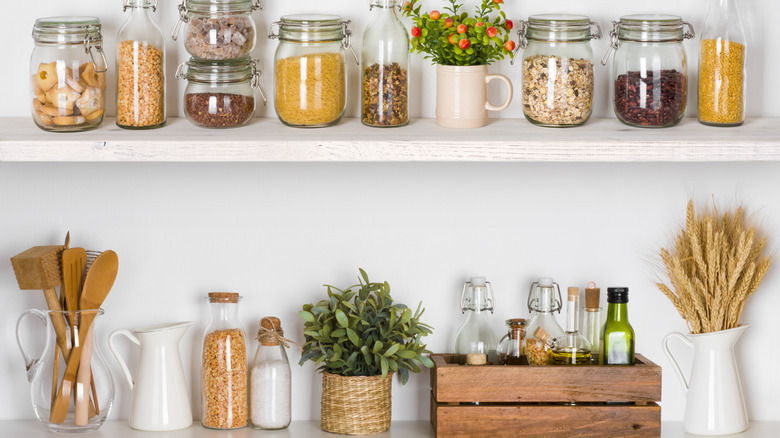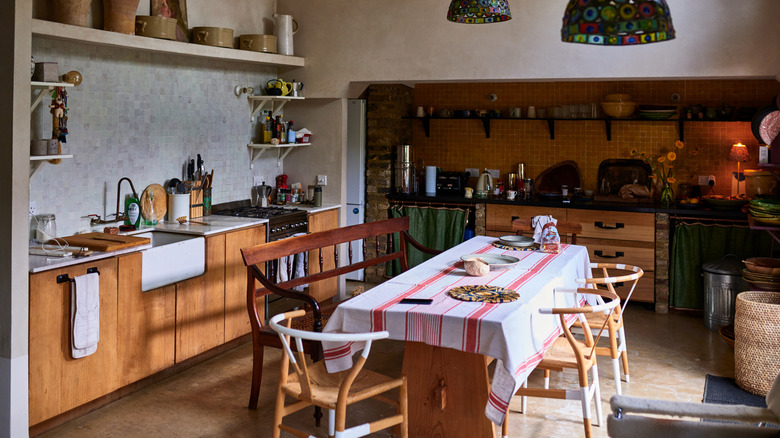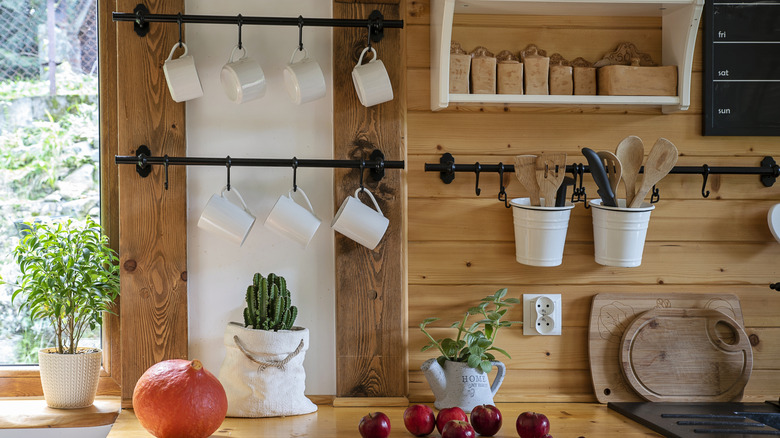15 Affordable Ways To Design A Tuscan-Style Kitchen
You can instantly recognize a Tuscan-style kitchen when you step into one: saturated terracotta hues, natural materials, and the constant, inexplicable smell of something cooking. A subgenre within the larger world of Mediterranean-style kitchens, Tuscan design is grounded in rustic materials and earthy hues sans coastal influences. Inspired by the sun-kissed landscapes of its namesake city in Italy, this interior style is an ode to slow, intentional living. Timeless in its appeal, every corner of the Tuscan kitchen feels like it has been lovingly collected over time or passed down through generations. If you are looking to break free from cookie-cutter kitchen designs, the homely Tuscan vibe is guaranteed to make your dinner guests stay just a little while longer.
If you want to bring this aesthetic to life in your kitchen without blowing through a tight budget, Surjit Singh Namli, founder and creative director of Artique Designs, has the answers you seek. From handy workarounds for expensive-looking countertops to the best places to find affordable lighting, everything you need to know for putting together a Tuscan-style kitchen on a budget lies ahead.
Design inspiration
Great design is not something that can be theorized or learned from a book — often, it starts by chasing down a fleeting feeling. This principle especially holds true when designing Tuscan-style kitchens.
Creative director of Artique Designs Surjit Singh Namli generally prompts his clients to reach into their vault of memories and pick out a specific mood. "What does warmth mean to you? What smells, colors, and textures make you feel at home?" he queries. Singh Namli explains that inspiration can be found in bountiful ways, whether it is the nostalgic smells emanating from your grandma's spice drawer or the hypnotic way in which light streams through old, shuttered windows. "Or even a meal shared in a countryside trattoria years ago," he adds.
Once you have a basic sense of the mood you are hoping to capture with your Tuscan kitchen, Singh Namli suggests piecing together the larger picture by scouting for inspiration in vintage markets, estate sales, and travel photography books. For example, he has found that older Italian films can also serve as inspiration for the texture and tone of a Tuscan kitchen. "You're not just recreating a look; you're capturing a way of life," Singh Namli says. "One that's generous, grounded, and beautifully unpretentious."
Colors
Finding the right colors for your kitchen is often considered an aesthetic decision. But when trying your hand at Tuscan-style interiors, you will find that your choice of hues plays a key role in dictating how your kitchen feels. After all, a rustic mélange of nature-inspired hues can invite warmth in a way that clinical white walls simply cannot.
As a rule of thumb, it helps to know which family of colors you need to gravitate toward before you can start shortlisting the hues that speak to you. Inspired by natural landscapes, Tuscan interiors immediately evoke visuals of olive groves, clay soil, and sunny hills, explains Surjit Singh Namli. He believes that it helps to lean towards earthy hues, such as terracotta, burnt sienna, dusty olive, soft ochre, and warm creams. He notes, "These tones are timeless and have a way of making even the simplest materials look elevated."
If you're looking to reconcile your grand plans of a homey Tuscan kitchen within a tight budget, there are some workarounds to opt for. According to Singh Namli, limewash or textured paint finishes can add some depth and patina without burning a hole in your pocket. Even a solitary accent wall doused in a chalky terracotta or golden beige can infuse a sense of nostalgia into the space. "And when you layer that with natural light," Singh Namli says, "even the humblest kitchen begins to glow."
Materials
Once you have zeroed in on the right colors, it's time to consider the materials that you will be using them on. From countertops and cabinets to backsplash and flooring, every actor plays an important role in this ensemble. Tuscan style hinges on a perfect sense of imperfection. What does this mean in layman's terms? Simply put, you can leave the flawless marble and handcrafted tiles behind. Do not fear blemished surfaces. Surjit Singh Namli has found that slightly worn and uneven surfaces help infuse an authentic sense of warmth. "The key is [to use] tactile materials, surfaces that invite you to touch, lean, cook, and live," he says.
Singh Namli recommends piecing together your dream Tuscan kitchen on a budget by scouting for textured laminates that look like weathered wood. He has also given his nod of approval to hand-painted and artisanal ceramic tiles. If you're designing on a budget, you can even choose concrete for your countertops by ensuring that it's sealed to deflect stains. "Reclaimed wood, if available locally, is a great option and tells a story in every knot and crack," he adds.
Furniture
Beyond mere functionality, furniture plays a major role in determining how you use your space. Banquette seating is where post-dinner coffees and conversations linger, while wicker chairs can turn a few spare inches of space around the kitchen island into a cozy breakfast nook. Pristine dining sets and matching chairs? The earnest Tuscan design enthusiast does not know them. Instead, Surjit Singh Namli suggests selecting furniture that encourages leisurely shared meals and "slow Sundays." The end goal? To create a space that feels like it has been curated over time, rather than blindly picked out of a showroom catalog. "A large rustic wooden table is often the anchor. You don't need a designer piece — an old farm table or even an upcycled door mounted on a frame can do the trick," he says.
Once you have the focal point squared away, you can start layering in thoughtful yet budget-friendly touches; Singh Namli suggests mixed-and-matched chairs, weathered vintage benches, and secondhand wrought-iron stools. "Don't be afraid of imperfection, painted legs, distressed wood, [or] uneven edges," Singh Namli says, adding that "these are the details that make the space feel lived in and real."
Countertops
From glistening granite to classic quartz, you'll find a wide array of countertop materials to choose from. So, how do you thin out the herd? Above all else, Surjit Singh Namli treasures materials that impart a "feeling of permanence." After all, Tuscan kitchens are designed to stand the test of time, rather than follow the dizzying carousel of here-today-gone-tomorrow trends.
So, what does this design philosophy mean for your choice of countertops? You might bump into stone countertops everywhere you look for design inspiration, and while they are ideal, they aren't absolutely essential. "Concrete countertops, when done well, offer a similar weight and presence at a fraction of the cost," Singh Namli says. You can also consider opting for laminate surfaces with a stone or travertine effect, per his recommendation. He also believes that butcher block countertops would be another solid choice, noting how this material and look "brings warmth and patina over time." While the latter doesn't require much by way of maintenance, it helps to bear in mind that these countertops aren't as heat resistant as other materials. To avoid burns and scorch marks, you'll want to stash hot pads and trivets within reach.
Cabinets
A true toast to form and function, cabinets bring major main character energy to the kitchen. And in case you haven't clued in yet: Simplicity rules the roost in a Tuscan kitchen. In Surjit Singh Namli's rulebook, shaker-style or flat-panel cabinets are best doused in calming hues, such as moss green, ivory, or warm grey, to create a solid foundation.
The good news is that you needn't start bailing out your retirement fund to outfit your space with show-stopping cabinets — not if you have this guide to buying affordable kitchen cabinets up your sleeve. Those working on a budget can take heart in the fact that standard hardware can be swapped for alternatives that bring some character to the space — iron pulls, ceramic knobs, and antique brass handles all score high in Singh Namli's book. Looking to make your existing cabinets work? Fret not, for a simple coat of paint with a chalky finish will help your cabinetry get with the memo. Singh Namli also recommends distressing them slightly to add both texture and charm. "Open shelving mixed with closed cabinets is another way to save costs while keeping things airy and organic," he says.
Lighting
On paper, kitchen lighting can seem like an essential element to ensure adequate visibility for all the chopping and cooking that needs to happen. But within the realm of Tuscan-style kitchens, lighting also helps douse the space in a warm, welcoming glow. Forget minimalist chandeliers and avant-garde recessed lighting. Instead, you'll want your lighting to take a walk down the scenic route. "Forged metal pendants, vintage chandeliers, or even wall sconces with frosted glass shades can work wonders," Surjit Singh Namli says. As a rule of thumb, it helps to place wall sconces at eye level to avoid any harsh glares, while an antique chandelier can be used above the kitchen island to anchor the room visually. Unsurprisingly, stark white light receives a thumbs down. "Instead, opt for warm-toned bulbs to create that golden-hour glow," Singh Namli suggests.
To keep your lighting choices in line with your budget, he encourages scouring flea markets, thrift stores, and online marketplaces. "Sometimes, an old lantern-style pendant or a mismatched set of wall lights can be rewired and repurposed beautifully," Singh Namli explains. "It's about finding character, not uniformity."
Flooring
First things first: It helps to establish a mood and ambiance before selecting flooring. It should come as little surprise that earthy, rustic finishes are headlining the list here. You'll want to remain unfazed by imperfections, slight chipping, and distressed details, which can add volumes of character to your kitchen and impart a lived-in feel. According to Surjit Singh Namli, flooring choices for a Tuscan-style kitchen should emit an earthy feel — one that encourages you to pad around barefoot rather than a polished lacquer that you have to tiptoe around.
So, what does this mean for your shopping list? "If terracotta tiles aren't within reach, look for ceramic or vinyl tiles that mimic their warmth and texture," Singh Namli says. "Distressed wooden laminate flooring also works well, especially in medium to dark tones." If you are unafraid of unconventional finishes, textured concrete or microcement finishes also score high on his list — you'll also find a skim coating of concrete popping up in this round-up of affordable backsplash designs. For adding a layer of softness to the exposed cement, Singh Namli recommends adding in natural rugs or a worn runner.
Decor
There is nothing accidental in a quintessential Tuscan kitchen: Every object is intentionally chosen and tells a story of its own. The memo carries forward to your decor choices, with thoughtful additions finding favor over jumbled souvenirs and mementos.
When decorating a Tuscan-style kitchen, Surjit Singh Namli finds that it is helpful to let your memories lead the way. After all, decor doesn't have to be expensive to make an impact; it simply has to be meaningful and intentional. "Use items that tell a story — a basket of fresh herbs, a wall of vintage copper pans, family photos in mismatched frames, or an old spice rack filled with your grandmother's masalas," he says. If you are looking to score some unique gems on a budget, it helps to browse through this round-up of unexpected places to find affordable kitchen decor. But Singh Namli believes that your own attic can also often yield unexpected pieces that you may have forgotten about.
If you have any walls sitting empty, you can turn this blank canvas into a gallery wall as a visual feast for the eyes. From food-themed artwork to vintage prints, there are endless ways to make this space your own, but it helps to ground your selection within the preferred Tuscan color palette of sunbaked hues. Think rustic browns, sage greens, and honeycomb yellow.
Backsplash
The humble backsplash is a workhorse that plays a key role in modern kitchens: shielding your walls from food spills, splatters, and grease. Its work doesn't end there, though, because it can also serve as a worthy player in your kitchen's Tuscan design narrative. Anything handcrafted has Surjit Singh Namli's nod of approval. "Affordable ceramic tiles with irregular edges or soft glaze finishes can do the trick," he says. "Subway tiles in warm tones, tumbled stone mosaics, or peel-and-stick faux terracotta tiles can also work beautifully when installed with care." Singh Namli explains that those willing to embrace a rustic look in their kitchen's design can even choose to paint and seal a plastered wall behind the stove.
If your budget for the backsplash is razor thin, you can opt for peel-and-stick tiles in Tuscan-approved patterns and finishes, such as this aged travertine option from Aspect on Amazon that can be assembled within a few hours. The muddish red hues of brick also slot well within the design parlance of Tuscan kitchens — faux brick panels made from slim layers of actual brick make for a budget-friendly substitute.
Shelving
When outfitting your Tuscan kitchen with all the bells and whistles, you won't want to sleep on adequate shelving. "Use shelves to display everyday items," Surjit Singh Namli recommends, such as stacked plates, glass jars filled with lentils or pasta, or clay pots. "It's both storage and story," he says of their purpose.
Open wooden shelves are a simple yet classic place to get started. Singh Namli suggests keeping an eye out for reclaimed timber or inexpensive planks that can be easily topped off with matte wax or oil. While floating shelves are a common fixture in modern kitchens, he recommends using iron brackets to add old-world charm. If you are looking to keep things within budget, you can simply take the door off any existing cabinet to reveal cubby-style open shelves within. For those running low on space, freestanding shelves make for an easily portable option that can be moved around as needed — keep an eye out for vintage baker's racks the next time you stop by a flea market. They make a handy resting place for plates and other dinnerware.
Sink
Every element of your kitchen can serve as a canvas for painting your design story. When chosen with care, an old-world sink can add volumes of character to the space. Farmhouse-style sinks are a mainstay in every Tuscan kitchen, and it is easy to see why. Available in a wide array of materials, including copper and fireclay, these sinks are characterized by their signature exposed, front-facing design. However, they can often come with a heavy price tag.
Fortunately, Surjit Singh Namli has a few handy workarounds up his sleeve. "Look for white ceramic or deep stainless-steel options with a wide, open basin," he says. A vintage-style faucet in either brushed bronze or matte black can serve as the perfect finishing touch. "Even a simple inset sink can feel appropriate if surrounded by natural textures and good lighting," Singh Namli adds.
Storage
A place for everything, everything in its place — it's a mantra that serves as the lifeblood of any efficient kitchen. When considering storage options for your Tuscan kitchen, you will want to favor rustic materials that have a story to tell, such as storage cabinets made from recycled or distressed wood.
According to Surjit Singh Namli, storage needs to be both vertical and open. For something that's both aesthetically pleasing and practical, he suggests options like open baskets, wrought-iron hooks, or even hanging pots on a repurposed ladder. You will also find that your functional storage options can easily add to the space's decor, such as an antique wooden hutch that can serve as a pantry while also creating visual impact. "Use beautiful things for storage — jars, baskets, [or] ceramic crocks — so your necessities become part of the display," Singh Namli advises. Wooden crates can also be angled creatively in an unused corner of the kitchen to store fresh produce.
Soft furnishings
You may have all the hard surfaces, such as countertops and cabinets, squared away, but it is essential to make a quick pitstop in the soft furnishings aisle before your work is done. Surjit Singh Namli believes that you needn't empty out your bank account to furnish your Tuscan kitchen with softer textures — you need just a delicate touch for adding soul and lived-in warmth.
So, what would you find in his shopping cart when kitting out a Tuscan-style kitchen? Materials like cotton, linen, or wool. Singh Namli also suggests choosing warmer colors like a worn-looking off-white, clay, olive, or mustard hue, which give off a comforting vibe. "A simple curtain instead of cabinet doors, a vintage runner across the floor, or a cushion on a bench can add just enough softness to balance the harder textures," he says. You can also choose to string up a sink skirt to keep the unsightly jumble of pipes hidden, while adding old-world appeal to your kitchen.
Finishing touches
With all the nuts and bolts put together, your work here is done — or almost. By peppering in some thoughtful touches, your Tuscan kitchen can really start to sing. The cues for these finishing flourishes will need to be taken from your own personality: Do you like waking up to the smell of fresh herbs on the windowsill, or would you like to end the night sipping coffee under the glow of wrought-iron candle holders?
Surjit Singh Namli agrees. Noting that everything is fair game, he recommends sticking with inexpensive but intentional items, anything from hand-thrown pottery to bunches of dried lavender knotted together with twine. At the end of the day, it is the intangible elements that can bring everything together, such as the perennial scent of a dessert baking away in the oven. When your newly designed space starts being used and feels lived-in, Singh Namli concludes, "That's the real finishing touch."
